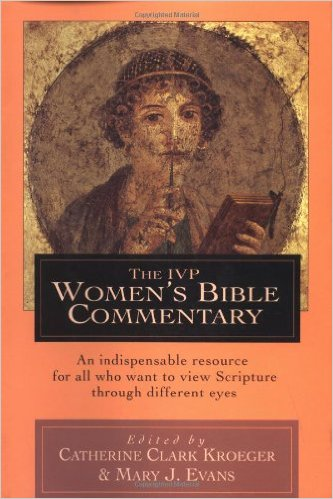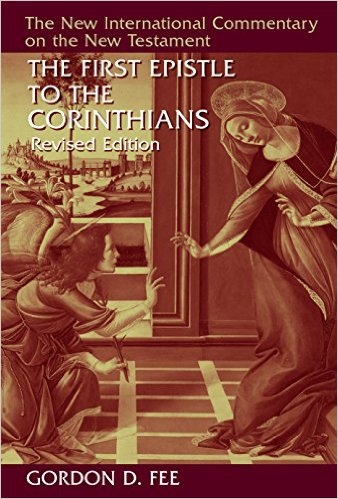出典:
目次
- 6. Catherine Clark Kroeger, "The Classical Concept of Head as 'Source'"
- An Important Unanswered Question
- 7. (1987) Gordon D. Fee, The First Epistle to the Corinthians 77
6. Catherine Clark Kroeger, "The Classical Concept of Head as 'Source'"

Catherine Kroeger女史の執筆による女性のための聖書注解書(IVP 出版社)
This article by Catherine Kroeger cites many passages from Greek literature in an attempt to demonstrate that kephale¯ meant “source” in the ancient world. Many have found this essay persuasive and thought it did what needed to be done; that is, they have read it and concluded that it finally produced many examples where kephale¯ clearly means “source” and found these examples in classical Greek literature as well. (Note that the title claims to be considering the “Classical concept” of head as source.)
In response, the first point that must be made is that the essay is wrongly and in fact misleadingly titled. The essay is not at all about “the Classical concept of head as source” but rather should be titled, “The Late Patristic Concept of Head as Source.”
In fact, four of the six authors Kroeger quotes in order to show that kephale¯ means “source” are taken from the entry in Lampe’s Patristic Greek Lexicon (p. 749), and the actual quotations she gives in her article are also taken from that entry on kephale¯.

Lampe’s Patristic Greek Lexicon
Second, are these quotations persuasive? The actual new quotations given in Kroeger’s article, in addition to the material from Philo, Artemidorus, and the Orphic Fragments (all of which have been examined above), include the following six authors (but Kroeger does not mention the date of any of them):
1. Athanasius (fifth century a.d.)
2. Cyril of Alexandria (died 444 a.d.)
3. Theodore of Mopsuestia (died 428 a.d.)
4. Basil (the Great) (329-379 a.d.)
5. Eusebius (died 339 a.d.)
6. Photius (died 891 a.d.)

アタナシオス(5世紀)
Apart from these six late patristic writers, Kroeger cites no new metaphorical uses of kephale¯ in her article. (See below on her non-metaphorical examples from all periods of Greek literature.)
This means that in her article full of extensive citations of Greek texts, an article that therefore gives the appearance of extensive citations of “Classical” Greek literature (literature from long before the time of the New Testament), Kroeger has misleadingly claimed in her title to be giving such evidence. She has also concealed that fact from readers by failing to give any dates for the patristic writers she quotes.
Since all the additional metaphorical examples cited come from the fourth century a.d. and later, it does not seem that they are very helpful for determining New Testament usage, especially in light of Ruth Tucker’s research showing that earlier Fathers took kephale¯ to mean “authority” and not “source.”74
Here it is appropriate to quote what Berkeley and Alvera Mickelsen say about such late material: “Our question is not what kephale¯ meant in a.d. 500 but rather what Paul meant when he used kephale¯ when writing his letters to the churches in the first century.”75
Yet another highly misleading aspect of Dr. Kroeger’s quotations is that she translates them in such a way that it appears that the authors are defining head to mean “source,” whereas that is not at all a necessary translation. For example, she translates a quotation from Cyril of Alexandria as follows:
Therefore of our race he become first head, which is source, and was of the earth and earthy. Since Christ was named the second Adam, he has been placed as head, which is source, of those who through him have been formed anew unto him unto immortality through sanctification in the spirit. Therefore he himself our source, which is head, has appeared as a human being. . . . Because head means source, He established the truth for those who are wavering in their mind that man is the head of woman, for she was taken out of him. (p. 268).
Kroeger then says, “In case you have lost count, kephale¯ is defined as ‘source’ (arche¯) no less than four times in this single paragraph” (p. 269). The texts would then all read, “head, which is ruler.”
What Kroeger fails to tell the reader is that in every one of these sentences where she renders “head, which is source,” we could also translate the word arche¯ as “ruler” or “leader” or “beginning” (without any connotation of source). Kroeger fails to tell the reader that these texts are still somewhat ambiguous, because the word arche¯ can mean either “beginning” or “ruler, authority.”76
Moreover, several of the quotations Kroeger gives regarding authors who comment on 1 Corinthians 11:3 are from orthodox writers who were involved in the great Trinitarian controversy of the fourth and fifth centuries. None of them would have said that God the Father was the “source of being” of God the Son in any sense that would have meant that the Son was created.
Yet we should note that in 1 Corinthians 11:3 Kroeger and many others who argue for the meaning “source” must have the meaning “source of being” in order for Christ to be the “head of every man” and the man to be the “head of the woman” in reference to Adam and Eve.
But this sense of “source” will simply not fit any orthodox conception of 1 Corinthians 11:3, for then it would mean that the Son was created. How could these quotations then mean that God was the source of Christ in that sense? For no orthodox writer would have said anything that implied that the Father created the Son.
Furthermore, even if one were to grant that Kroeger has found some examples where kephale¯ takes the meaning “source,” the point still remains that there is no instance of “source” apart from authority. For example, the Son is never said to be the “head” of the Father, nor is the wife ever said to be the “head” of the husband. The conclusion is that “head” again (and as in all the earlier cases) always applies to the one with greatest authority, and even if one sees a nuance of “source” in some of these texts, the nuance of authority inevitably goes with it.
Another line of argument in Dr. Kroeger’s article is the listing of many examples in which the physical head of a person is seen as the “source” of various things such as hair, nasal secretions, earwax, and so forth (pp. 269-273). Kroeger asks, do these texts not show that head could mean “source” in Greek literature? (These texts come from various periods of Greek literature, including several near the time of the New Testament. In this respect they are unlike the late metaphorical examples that I mentioned above.)
No, they do not show that at all. These simply refer to the physical head of persons and describe functions that can be observed. These texts do not use kephale¯ metaphorically to mean source. We can see that if we try to substitute the word “source” in a statement like some of those mentioned in Kroeger’s article: might someone say (for example), “I see luxuriant hair growing from your source today”? Or might someone say, “Your source is giving off abundant nasal secretions this morning”? Certainly those statements would be nonsense, and they show that “source” was not a suitable meaning or synonym for “head” in any of those statements.
An Important Unanswered Question
After all the research on this word by myself as well as by Cervin, Payne, Bilezikian, Kroeger, and others, there is still an unanswered question:
Where is even one clear example of kephale¯ used of a person to mean “source” in all of Greek literature before or during the time of the New Testament? Is there even one example that is unambiguous?
If there is still not one clear example before or during the time of the New Testament, then how can many writers go on saying that this is a “common” meaning at the time of the New Testament? Or even a possible one? Perhaps such examples will be forthcoming, but until they are it would seem appropriate to use much more caution in the statements that are made about “source” being a common or recognized meaning for kephale¯. We still see much reason to doubt that it was a recognized meaning at all.
7. (1987) Gordon D. Fee, The First Epistle to the Corinthians 77

This treatment of 1 Corinthians 11:3, and particularly the meaning of kephale¯ in that text, quotes the 1954 article by S. Bedale, and then quotes the recent articles discussed above by the Mickelsens, Payne, and Kroeger. Fee calls Kroeger’s paper on the “Classical concept of head as source” “a paper that appears to be decisive” (p. 502). In addition, from Payne’s article Fee quotes the statement from Orphic Fragments 21a, the two quotations from Philo, and the quotations from Artemidorus.
Fee concludes that kephale¯ in the sense of “chief” or “person of highest rank” is “rare in Greek literature” (p. 502). He says,
“Paul’s understanding of the metaphor, therefore, and almost certainly the only one the Corinthians would have grasped, is ‘head’ as ‘source,’ especially ‘source of life’” (p. 502).
He gives as evidence the quotations just noted. Fee also takes issue with my study of kephale¯ for four reasons:
1.Of my 49 examples, he says 12 are from the NT, and these are examples that “[Grudem] prejudges exegetically” to mean authority over.
2.Of the other 37 examples, 18 are from the Septuagint, “which are exceptions that prove the rule.”
3.He then says, “For most of the remaining 19 there is serious exegetical question as to whether the authors intended a metaphorical sense of ‘authority over.’”
4.He says that I am “quite mistaken” in my use of Philo, because two passages in Philo show the meaning “source.”78
In response to those four points:
1. I am not sure what Fee means when he says that I “prejudge exegetically” the New Testament passages. In my earlier article I discussed each passage. Fee by contrast offers no discussion in return. Is he implying that since my discussion concluded that kephale¯ means “authority over,” it is invalid to count these examples? But when Fee provides no exegetical arguments of his own about any other passages than 1 Corinthians 11:3, one wonders if it is not he who has “prejudged” the meaning of these texts.
2. As I explained above, it seems inconsistent to say that 18 examples from the Septuagint are exceptions “that prove the rule” and then reject the sense “authority over,” which is established by these 18 examples but accept the sense “source” where there are zero examples from the Septuagint.
3. Fee gives no evidence, no argument, no hint of what these “serious exegetical questions” are in the other citations. His statement is simply dismissal by assertion, with no argument or supporting evidence.
4. Regarding the two examples in Philo that speak of a person becoming the “head” of the human race and of the “head” of an animal, the meaning “source” is certainly not clearly established, as was indicated in the discussion above.79
Such analysis in a prominent commentary series is puzzling, to say the least. The survey above has shown that not only Fee, but also Kroeger, the Mickelsens, Payne, and Bilezikian all dismiss the meaning “authority over” as “rare,” but say that the meaning “source” is “common.”
Perhaps we can be forgiven for realizing that all of these six writers have also been vocal proponents of an “evangelical feminist” position that seeks to deny any unique leadership role for men in marriage or the church and for wondering if their strong commitment to this viewpoint has affected their judgment on the meaning of kephale¯.
It is of course possible that my own judgment on this issue is distorted as well, but as I review the data once again, it seems strange that they have taken the meaning “authority, ruler,” which is attested over forty times in ancient literature, including about sixteen times in the Septuagint, and called it “rare.”
On the other hand, these authors have taken the meaning “source,” for which there are only one possible example in the fifth century b.c. (Orphic Fragments, 21a), two possible (but ambiguous) examples in Philo, no examples in the Septuagint, and no clear examples applied to persons before or during the time of the New Testament, and called it a “common, recognizable, ordinary meaning.”
What kind of logic is this? Forty examples make a meaning “rare” but zero unambiguous examples makes the meaning “common”? The meaning “authority over,” which is in all New Testament Greek lexicons, is unlikely and rare and “not part of the ordinary range of meanings for the Greek word,” but the meaning “source,” which is in no lexicon for the New Testament period and is reflected in none of the early Fathers, who took it to mean “authority,” is called “almost certainly the only one the Corinthians would have grasped” (Fee, First Corinthians, p. 502).
I confess that I find it hard to follow this line of reasoning. It seems to me that we have yet to see convincing evidence that kephale¯ ever did mean source at the time of the New Testament.
(本論文の傍線、強調はブログ管理人によります。Emphasize mine.)
註:
74.See above, p. 454.
75. Mickelsen and Mickelsen, Women, Authority and the Bible, p. 100.
76. See BAGD, p. 112; G. W. Lampe, Patristic Greek Lexicon (Oxford: Oxford University Press, 1968), pp. 235-236; Liddell-Scott, p. 252, for arche¯ meaning “ruler, leader, authority.” For the texts which Kroeger quotes from Chrysostom and Athanasius, the translations given in Philip Schaff, ed., A Select Library of Nicene and Post-Nicene Fathers of the Christian Church (28 vols. in two series [1886-1900]; reprint ed., Grand Rapids: Eerdmans, 1952ff.), are not “source” (as Kroeger translates) but “first principle” (Chrysotom, Homily 26 on 1 Corinthians 11, NPNF, first series, 12:151, col. 2) and “beginning” (Athanasius, De Synodis 27:26, NPNF, second series, 4:465, col 2).
77. New International Commentary on the New Testament series (Grand Rapids, MI: Eerdmans, 1987), pp. 501-505 (commentary on 1 Corinthians 11:3)
78. These four objections are on pp. 502-503, n.42.
79. See above.